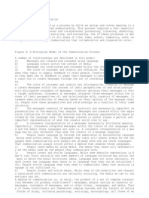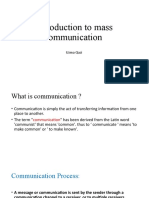Virtual Organization
Virtual Organization
Uploaded by
Omkar Shirish DatarCopyright:
Available Formats
Virtual Organization
Virtual Organization
Uploaded by
Omkar Shirish DatarCopyright
Available Formats
Share this document
Did you find this document useful?
Is this content inappropriate?
Copyright:
Available Formats
Virtual Organization
Virtual Organization
Uploaded by
Omkar Shirish DatarCopyright:
Available Formats
Vir tual Organization
Names Nisha Mohammad Omkar Datar Salman Khan Samah Kazmi Click to edit Master subtitle style Zarna choksi Zeba Qureshi Roll no. 67 68 87 88 113 114 3/20/12
Definition: A Virtual Organisation (VO) is a group of individuals collaborating through the use of online services (VO = People + Services) In business an organization that can take one of the following forms:
a business which operates primarily via electronic means; see virtual business independent organizations that share resources to achieve their goals; see virtual enterprise
Concept
Virtual organization (grid computing) a group who shares the same computing resources
3/20/12
People Management: Virtual organizations thrive on the competence of the people who comprise the organization; as such managers in virtual organizations are more sensitive and responsive and adopt more sophisticated HRM techniques and systems than those in conventional organizations.
Relationship Management: The integrated network of people, processes, suppliers, vendors and partners is a key element of virtual organizations and as such managers of virtual organizations take more care to nurture and support the elaborate network of people an d firm interaction that exist in a virtual environment.
Difference from conventional
3/20/12
Knowledge Management: The transfer of both codified and uncodified knowledge presents a serious challenge to the continued success of the virtual organization. For knowledge transfer to happen effectively, then an appropriate system has to be instituted to facilitate and ensure the sharing of both structured and unstructured forms of knowledge. Technology Management: It is difficult, perhaps un-imaginable to discuss the concept of a virtual organization without reference to technology infrastructure required to make this possible. The technology consideration is on the network design, information flow and processes, IT infrastructure such as VOIP, teleconferencing, document sharing etc.
Difference from conventional
3/20/12
Potential advantages identified by the cited experts included:
Swifter reaction times to new products emerging in global and local markets; The opportunity for switching suppliers and human resources in accordance with stated objectives; Reduction of expenses involved by the necessity of using working spaces rent, maintenance, insurances etc.; More efficient usage of office space, in the case when some employees work according to the traditional system, while others prefers a telecommuting system; etc.;
Advantages gas, electricity, water Diminishing utilities expenses
3/20/12 Reduction of the consumption of consumable materials;
Decrease of salary expenses, as the virtual team members are paid for their task and not for their time spent at work; Possibility to have experts located in any part of the globe; Possibility to hire low cost but qualified labor force (recruiting the personnel can be done in geographic areas where the labor force is low cost and well trained); Increase of productivity and performances due to the fact that virtual team members can better focus on the results to be achieved; Reduction of the number of absentees because the virtual team members work at home; disadvantaged areas.
Advantages opportunities in rural or Creation of jobs and employment
3/20/12
Added complexity due to the participants being distributed to multiple geographical locations and restricted from face-to-face interaction (Bjorn & Ngwenyama); Increased risk of communication breakdowns due to cultural and organizational differences inherent to participants from geographically diverse regions of the world (Bjorn & Ngwenyama); Reduced productivity due to a lack of shared meaning and cohesiveness that shared meaning can produce between members of an organization (Bjorn & Ngwenyama; Peters & Manz, 2008);
For those who telecommute i.e. work home, Limtations self-disciplineatand an reduced productivity due to lack
overabundance of distractions around the home 3/20/12 (Hortensia).
What are the steps to a virtual organization?
outsourcing mainly to reduce costs where there is some experience in working at a distance, but three is one dominant party and high certainty of what everyone must do. forming strategic alliances to share the work and gain experience in developing and sharing common goals. Here there is no dominant party although the parties are fixed. and then becoming virtual organizations to achieve flexibility. Now the partners themselves can quickly change, with greater emphasis on the use of knowledge to create new and innovative products. It is of course possible for only a part of an organization to become virtual. In that case organizations can gradually 3/20/12 evolve from real to virtual.
How they work
What are the reasons for organizations becoming virtual?
Globalization, with growing trends to include global customers, Ability to quickly pool expert resources, Creation of communities of excellence, Rapidly changing needs, Increasingly specialized products and services, Increasing required to use specialized knowledge Working electronically. In a virtual organization all places of work would be through communication using computer workspaces. You can the go from electronic workplace to workplace to 3/20/12 see the activities that are taking place in the organization.
Tools for optimization
You might also like
- Assignment/ Tugasan - Communication LawDocument11 pagesAssignment/ Tugasan - Communication LawTATABA farmNo ratings yet
- BB211 - Chapter 8 - Internal CommunicationsDocument27 pagesBB211 - Chapter 8 - Internal CommunicationsHannah Ma Ya LiNo ratings yet
- Unit 6 Practice QuizDocument5 pagesUnit 6 Practice Quizmalrahem10% (1)
- Generational Differences in The WorkplaceDocument7 pagesGenerational Differences in The Workplacedionisiabenson97No ratings yet
- Consumer Behaviour-Communication and Ads AppealDocument13 pagesConsumer Behaviour-Communication and Ads AppealmunirahhasrulNo ratings yet
- Inter Group Conflict in The WorkplaceDocument5 pagesInter Group Conflict in The WorkplaceRohit SatamNo ratings yet
- Generational Conflict in The Workplace CaseDocument2 pagesGenerational Conflict in The Workplace CaseSocheata NgethNo ratings yet
- Group Work in The Context of Virtual Learning EnvironmentDocument14 pagesGroup Work in The Context of Virtual Learning EnvironmentStephanie Rhea Nina SabioNo ratings yet
- Using Potter's Box To Make Ethical Decisions in MediaDocument1 pageUsing Potter's Box To Make Ethical Decisions in MediamshultsNo ratings yet
- Bovee bct10 PPT 07Document27 pagesBovee bct10 PPT 07itoiNo ratings yet
- Marketing Communications: UNIT 1-Foundations of IntegratedDocument21 pagesMarketing Communications: UNIT 1-Foundations of IntegratedPratik PatilNo ratings yet
- Canons of Journalism: The Forgotten and Unlamented Malaysian VersionDocument3 pagesCanons of Journalism: The Forgotten and Unlamented Malaysian VersiongrkrudraNo ratings yet
- Chapter 59 - Sources of InformationDocument5 pagesChapter 59 - Sources of InformationAKshita LaNiNo ratings yet
- Communication LectureDocument28 pagesCommunication LectureLiezel CauilanNo ratings yet
- Syllabus On Presentation SkillsDocument2 pagesSyllabus On Presentation SkillsL'Michelli Kilayko HorladorNo ratings yet
- Rubric For 4CsDocument2 pagesRubric For 4Csjaja jumarangNo ratings yet
- Public Relations Campaign Planning and ManagementDocument57 pagesPublic Relations Campaign Planning and ManagementsansanNo ratings yet
- Informative Speech Outline Public SpeakingDocument2 pagesInformative Speech Outline Public Speakingapi-291574045No ratings yet
- Communication Network of An OrganizationDocument47 pagesCommunication Network of An Organizationmeann71100% (11)
- Communication in Business - Unit 1Document17 pagesCommunication in Business - Unit 1YUVATHI.L BCOM 1No ratings yet
- UNIT 2 L5 Computer-Mediated CommunicationDocument21 pagesUNIT 2 L5 Computer-Mediated CommunicationYahra DatangNo ratings yet
- Country Report of MalaysiaDocument5 pagesCountry Report of MalaysiaFaris HashimNo ratings yet
- Models and Processes of Communication PDFDocument25 pagesModels and Processes of Communication PDFsara99_love100% (2)
- Mind The Gap: Technology, Millennial Leadership and The Cross-Generaional WorkforceDocument13 pagesMind The Gap: Technology, Millennial Leadership and The Cross-Generaional WorkforceCak RaSaNo ratings yet
- Introduction To CommunicationDocument5 pagesIntroduction To CommunicationXhiella Mhae Garces PaltepNo ratings yet
- Ethical Decision Making Model PDFDocument2 pagesEthical Decision Making Model PDFNinaNo ratings yet
- Importance of Business CommunicationDocument48 pagesImportance of Business Communicationsatyam skNo ratings yet
- Communication AssesmentDocument15 pagesCommunication AssesmentpwaingankarNo ratings yet
- Sample Functional ResumeDocument1 pageSample Functional ResumeNBNo ratings yet
- The Influence of Corporate Culture On Organizational Commitment: Case Study of Semiconductor Organizations in MalaysiaDocument17 pagesThe Influence of Corporate Culture On Organizational Commitment: Case Study of Semiconductor Organizations in MalaysiaSunway University100% (1)
- Audience Profile Plan: Samuel Ford - KingsDocument9 pagesAudience Profile Plan: Samuel Ford - KingsIsaac WinterburnNo ratings yet
- Construction of Media MessagesDocument16 pagesConstruction of Media MessagesBakirharunNo ratings yet
- Learning Outcomes For This Chapter:: Chapter Ten - Aligning Strategy and Organisational CultureDocument4 pagesLearning Outcomes For This Chapter:: Chapter Ten - Aligning Strategy and Organisational Culturestanely ndlovu100% (1)
- The Three-Step Writing Process in Business CommunicationDocument8 pagesThe Three-Step Writing Process in Business CommunicationJannelle Dwight TriñoNo ratings yet
- Communication Barriers Organizational BehaviorDocument19 pagesCommunication Barriers Organizational BehaviorAshok HmNo ratings yet
- Introduction To Mass CommunicationDocument20 pagesIntroduction To Mass Communicationhafsa rashidNo ratings yet
- Material For Oral Presentation Skills and AlsoDocument20 pagesMaterial For Oral Presentation Skills and AlsomorpheusneoNo ratings yet
- Media PlanDocument8 pagesMedia PlanketanshekharNo ratings yet
- Fou03 01 Organizational CommunicationDocument106 pagesFou03 01 Organizational CommunicationSuzanna CoombesNo ratings yet
- Syllabus: Visual Communication Three (3) Units Three (3) Hours Color TheoryDocument4 pagesSyllabus: Visual Communication Three (3) Units Three (3) Hours Color Theorynave sumidoNo ratings yet
- Generational Differences in The WorkplaceDocument25 pagesGenerational Differences in The WorkplaceElismarNo ratings yet
- Journalism SyllabusDocument5 pagesJournalism SyllabusJanardhan Juvvigunta JJNo ratings yet
- Business Communication by PriyaDocument13 pagesBusiness Communication by Priyapriya madan100% (1)
- Core Competency, Sbu AnalysisDocument18 pagesCore Competency, Sbu AnalysisROHAN GUPTANo ratings yet
- Leadership CommunicationDocument2 pagesLeadership Communicationveena9876No ratings yet
- Why Is Performance Appraisal ImportantDocument6 pagesWhy Is Performance Appraisal ImportantDavid RoyNo ratings yet
- History of Aristotelian or Linear ModelDocument3 pagesHistory of Aristotelian or Linear ModelKlent Mae Vergara BernarteNo ratings yet
- Presentation Skills - E-Learning-1Document6 pagesPresentation Skills - E-Learning-1Titin ParamidaNo ratings yet
- The Role of CommunicationDocument10 pagesThe Role of CommunicationMiguelNo ratings yet
- Management Styles 2014Document16 pagesManagement Styles 2014muyakihumbaNo ratings yet
- Objectives of AdvertisingDocument17 pagesObjectives of AdvertisingsamrulezzzNo ratings yet
- MT123 Business CommunicationDocument22 pagesMT123 Business CommunicationShantanu JahagirdarNo ratings yet
- Differences Between Generation Y and Z in The Workplace Concerning ManagersDocument4 pagesDifferences Between Generation Y and Z in The Workplace Concerning Managersmawadaa008No ratings yet
- Pierre BourdieuDocument16 pagesPierre BourdieuDarren ErwinNo ratings yet
- Geert Hofstede CultureDocument11 pagesGeert Hofstede CultureDolly Parhawk100% (1)
- Mass MediaDocument23 pagesMass MediaKhanifa BarringtonNo ratings yet
- Key Concept of Corporate CommunicationDocument14 pagesKey Concept of Corporate CommunicationSandhya MudaliarNo ratings yet
- Virtual OrganizationDocument15 pagesVirtual OrganizationChetan CGNo ratings yet
- IMS Notes For Exam PDFDocument21 pagesIMS Notes For Exam PDFIndulekha SunilNo ratings yet
- Virtual ORGDocument25 pagesVirtual ORGAyesha TanzeelNo ratings yet
- Using Technology To Transform The OrganizationDocument31 pagesUsing Technology To Transform The OrganizationMaria Louisa Cosa AnadillaNo ratings yet
- Research Methodology: Perpertual Succour Academy, IncDocument4 pagesResearch Methodology: Perpertual Succour Academy, IncKen FerrolinoNo ratings yet
- Psycho HeadlinesDocument12 pagesPsycho Headlinestonatiuh29100% (1)
- BAB 1 - Yes2Document9 pagesBAB 1 - Yes2widyaindahmg1No ratings yet
- MS 1Document1 pageMS 1Luigie Magat Larman IIINo ratings yet
- Animating The Visions of Richard LinklaterDocument3 pagesAnimating The Visions of Richard LinklaterPowerhouse Animation StudiosNo ratings yet
- Ica JD HR ManagerDocument3 pagesIca JD HR ManagerAsad MazharNo ratings yet
- Gcs Service Learning HandbookDocument24 pagesGcs Service Learning Handbookapi-249146140No ratings yet
- (Scientific American) Scientific American Mind - J (B-Ok - CC) PDFDocument80 pages(Scientific American) Scientific American Mind - J (B-Ok - CC) PDFBabak Asli100% (2)
- The Challenges of Parametric Design in Architecture Today PDFDocument115 pagesThe Challenges of Parametric Design in Architecture Today PDFshanmathi solaimalaiNo ratings yet
- GermanlitDocument6 pagesGermanlitapi-551541045No ratings yet
- Chapter 7 AS6 SS2Document4 pagesChapter 7 AS6 SS2Danny Kim PigarNo ratings yet
- NPTEL ML Assignment Week1Document5 pagesNPTEL ML Assignment Week1Prasannakumar S Asst.prof100% (3)
- How To Control MindDocument6 pagesHow To Control MindvishalNo ratings yet
- 10 Reasons Why Customer Complaints Are Good NewsDocument3 pages10 Reasons Why Customer Complaints Are Good Newsboahen appiah agyeiNo ratings yet
- IGNOU MBA MS-1 Free Solved Assignment 2012Document12 pagesIGNOU MBA MS-1 Free Solved Assignment 2012Shadab AliNo ratings yet
- Research1 - Module 5 - EleccionDocument6 pagesResearch1 - Module 5 - EleccionEcho Siason EleccionNo ratings yet
- Introduction To Expert Choice: National Institutes of Health Office of Research Services Office of Quality ManagementDocument16 pagesIntroduction To Expert Choice: National Institutes of Health Office of Research Services Office of Quality ManagementpatsarapornNo ratings yet
- Ecc 514 Multidisciplinary Meeting Participation Eryn White 1Document10 pagesEcc 514 Multidisciplinary Meeting Participation Eryn White 1api-617772119No ratings yet
- Dyspareunia Following Childbirth: Christine Kettle, Khaled Ismail and Fidelma O'MahonyDocument5 pagesDyspareunia Following Childbirth: Christine Kettle, Khaled Ismail and Fidelma O'MahonygedeNo ratings yet
- Evolution of Society and Culture in The PhilippinesDocument5 pagesEvolution of Society and Culture in The PhilippinesAko Si Benson100% (3)
- The Freudian Methods Applied To AngerDocument7 pagesThe Freudian Methods Applied To Angerkatherine_parra_1No ratings yet
- Minat BerwirausahaDocument12 pagesMinat BerwirausahardzkdayNo ratings yet
- Big City GreenDocument2 pagesBig City GreenRashmi BhandekarNo ratings yet
- Table of Specification SCIENCE 5 Quarter 2Document1 pageTable of Specification SCIENCE 5 Quarter 2JERIC PLE�AGONo ratings yet
- Eng II STAAR Persuasive Writing RubricDocument1 pageEng II STAAR Persuasive Writing RubricAbhinav BasvojuNo ratings yet
- Year 10 - Statistics and Probability Worksheet - SampleDocument1 pageYear 10 - Statistics and Probability Worksheet - SampleqwertyNo ratings yet
- 4 Disciplines of ExecutionDocument44 pages4 Disciplines of Executiondjdeeablo100% (13)
- Eng Moti 0Document2 pagesEng Moti 0Barış ErçeNo ratings yet
- Rosenberg Self Esteem ScaleDocument2 pagesRosenberg Self Esteem ScaleeldekaNo ratings yet

























































































